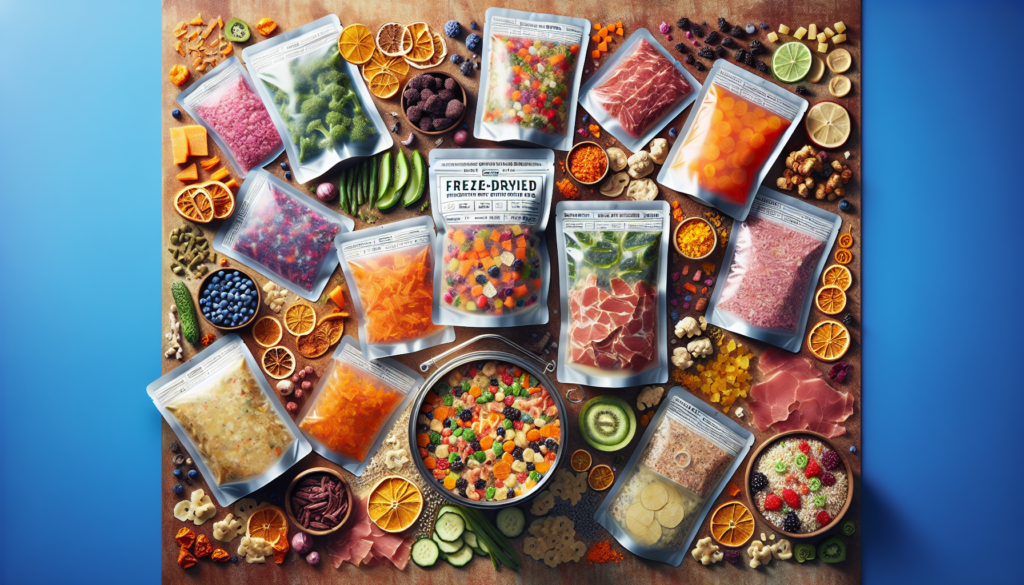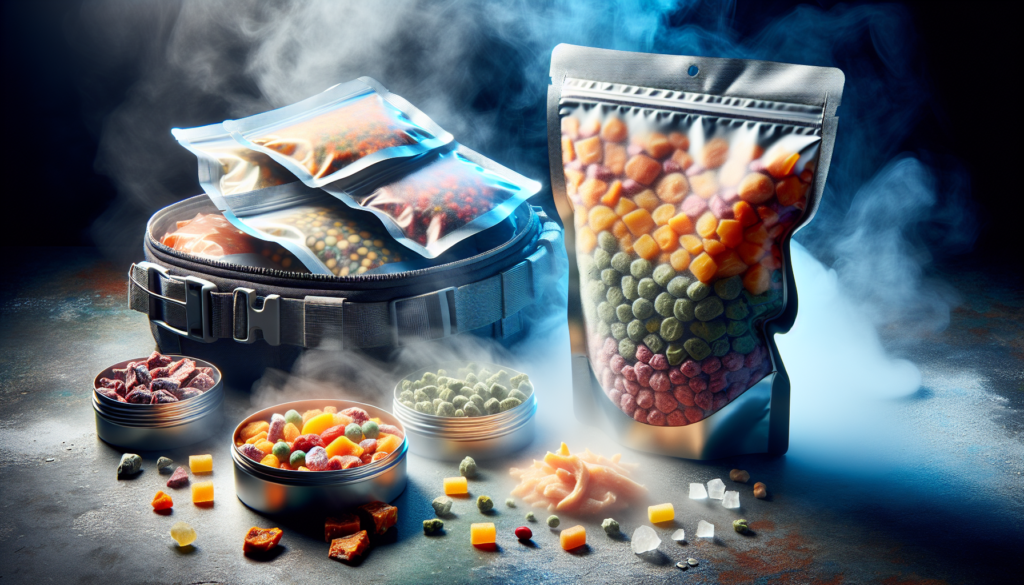If you’re a backpacking or camping enthusiast, then freeze drying is a game-changer for your outdoor cooking adventures. This article explores the incredible benefits and convenience of freeze drying when it comes to preparing meals for your next outdoor excursion. From lightweight and easy-to-pack meals to longer shelf life and preserved nutrition, freeze drying offers the perfect solution for those in need of delicious, nutritious, and hassle-free meals on the go. So, let’s dive into the world of freeze drying for backpacking and camping and uncover all the amazing ways it can enhance your outdoor culinary experiences.

Overview
If you’re an avid backpacker or a camping enthusiast, you’ve probably come across the term “freeze drying” when it comes to food. Freeze drying is a popular method of preserving food for outdoor activities, as it allows you to enjoy nutritious and delicious meals even when you’re away from home. In this article, we will explore the benefits of freeze drying, the process itself, how to choose the right freeze-dried foods, how to prepare and store them, as well as some tips for successful freeze-drying. So let’s dive in and discover the world of freeze drying for backpacking and camping!
Benefits of Freeze Drying
Why should you consider freeze-dried foods for your backpacking or camping adventures? Here are some key benefits:
-
Lightweight: Freeze-dried foods are incredibly lightweight, making them ideal for backpacking trips where every ounce matters. The water content is removed from the food, resulting in lighter and more compact meals that won’t weigh you down on the trail.
-
Long Shelf Life: Freeze-dried foods have a significantly longer shelf life compared to other food preservation methods. When properly stored, they can last for years, allowing you to stock up on your favorite meals without worrying about spoilage.
-
Nutritional Value: The freeze drying process preserves the nutritional content of the food, including vitamins, minerals, and antioxidants. This means that even when you’re away from civilization, you can still enjoy a well-balanced and nourishing meal.
-
Easy Preparation: Freeze-dried meals are incredibly easy to prepare. With just a bit of water and some time for rehydration, you can have a hot and satisfying meal in minutes, no complicated cooking or preparation required.
The Process of Freeze Drying
Freeze drying is a fascinating process that involves removing the moisture from food through a combination of freezing and sublimation. Here’s a brief overview of the steps involved:
-
Freezing: The food is first frozen to extremely low temperatures. This freezing process helps preserve the food’s structure and prevents the formation of ice crystals that can damage the texture and taste.
-
Sublimation: Once frozen, the food is placed in a vacuum chamber where the surrounding pressure is reduced. This low pressure causes the frozen water within the food to transition directly from a solid (ice) to a gas (water vapor) without passing through the liquid phase. This process is called sublimation.
-
Drying: As the water sublimes, it is removed from the chamber, leaving behind freeze-dried food. The food retains its original shape and structure but with the water content removed.
Choosing the Right Freeze-Dried Foods
When it comes to choosing freeze-dried foods for your backpacking or camping trips, there are a few factors to consider. Here are some tips to help you make the right choice:
-
Nutritional Variety: Look for a range of freeze-dried meals that provide a balanced nutritional profile. Consider options with proteins, carbohydrates, and fruits or vegetables to ensure you’re getting a well-rounded meal.
-
Quality Ingredients: Check the ingredient list to ensure you’re getting high-quality ingredients without any artificial additives or preservatives. Look for natural, whole-food options whenever possible.
-
Flavor and Variety: Explore different flavors and meal options to keep your taste buds engaged during your adventures. A diverse selection of freeze-dried meals will help prevent mealtime monotony.
-
Portion Size: Consider the portion sizes offered to ensure they match your appetite and caloric needs. Some brands offer individual servings, while others provide larger pouches for sharing or multiple meals.

Preparing Freeze-Dried Meals
Preparing freeze-dried meals is a breeze, and you’ll be enjoying a hot and satisfying meal in no time. Here’s a step-by-step guide to get you started:
-
Boil Water: Start by heating water to a boil. This can be done using a stove, campfire, or portable camping stove.
-
Open the Package: Open the freeze-dried meal package and remove the oxygen absorber if included. This small packet helps maintain the food’s freshness but is not meant to be consumed.
-
Add Water: Pour the boiled water directly into the package, following the instructions for the recommended amount of water. Typically, it’s a 1:1 ratio of water to freeze-dried food, but the instructions may vary depending on the meal.
-
Mix and Rehydrate: Stir the contents of the package thoroughly to ensure even distribution of water. Seal the package or fold it closed and let it sit for the recommended amount of time specified on the package instructions. This allows the food to rehydrate and absorb the water.
-
Enjoy your Meal: After the recommended rehydration time has elapsed, open the package and give the meal a final stir. Your freeze-dried meal is now ready to be enjoyed!
Proper Storage of Freeze-Dried Foods
To ensure the longevity and quality of your freeze-dried foods, proper storage is essential. Here are some tips to keep in mind:
-
Cool, Dark, and Dry: Store your freeze-dried meals in a cool, dark, and dry place away from direct sunlight and moisture. Excessive heat or humidity can affect the quality and shelf life of the food.
-
Airtight Containers: If you choose to repackage your freeze-dried meals, use airtight containers or resealable bags to protect them from air and moisture. Oxygen and moisture can degrade the food’s quality over time.
-
Rotation System: Practice a rotation system by consuming the oldest meals first and replenishing your stock with fresh freeze-dried foods. This helps ensure you always have a supply of high-quality meals for your outdoor adventures.
-
Regular Inspections: Periodically check your stored freeze-dried foods for any signs of spoilage, such as unusual odors, discoloration, or visible mold. If you notice any of these signs, it’s best to discard the food to avoid any potential health risks.
Rehydrating Freeze-Dried Meals
Rehydrating freeze-dried meals is a simple process, but there are a few tips to keep in mind for optimal results:
-
Hot or Cold Water: Most freeze-dried meals can be rehydrated using either hot or cold water, depending on your preference and circumstances. Hot water will expedite the rehydration process, while cold water will take longer but can be convenient when resources are limited.
-
Rehydration Time: Follow the package instructions for the recommended rehydration time. This typically ranges from 5 to 15 minutes, but it may vary depending on the meal. Avoid over-soaking the food, as it can become mushy and less appetizing.
-
Stirring and Mixing: Once you’ve added the water, stir the contents of the package thoroughly to ensure even rehydration. Pay attention to any clumps or dry spots and break them apart for a consistent texture and taste.
-
Testing for Readiness: When the recommended rehydration time has passed, taste a small portion of the food to check if it’s fully rehydrated. Adjust the water or time as needed to achieve the desired texture and flavor.
Tips for Successful Freeze-Drying
Here are some additional tips to help you achieve successful freeze-drying results:
-
Meal Planning: Plan your freeze-dried meals ahead of time and create a diverse menu to keep things interesting. Consider your nutritional needs, dietary preferences, and desired variety to ensure you have a well-rounded meal plan for your outdoor adventures.
-
Practice at Home: Before embarking on a backpacking or camping trip, it’s a good idea to try out your freeze-dried meals at home. This allows you to familiarize yourself with the preparation process and ensure you enjoy the flavors and textures of the meals.
-
Double-Seal Packaging: If you’re concerned about the longevity of your freeze-dried foods, consider taking an extra step to preserve their freshness. After opening a package, transfer the remaining contents to a separate resealable bag or container and double-seal it to minimize any exposure to air and moisture.
-
Labeling and Organization: When repackaging your freeze-dried meals, label each container or bag with the name and date of the meal. This will help you keep track of their freshness and rotation.
Common Mistakes to Avoid
To ensure a smooth and enjoyable experience with freeze-dried meals, be aware of these common mistakes and avoid them:
-
Insufficient Water: Always follow the package instructions for the recommended amount of water. Adding too little water can result in an under-hydrated meal, while adding too much can lead to a diluted flavor and mushy texture.
-
Overheating: When rehydrating the meal with hot water, be mindful of the temperature. Avoid using boiling water directly from a stove or campfire, as it can cause the food to overheat and lose its desired texture.
-
Not Stirring Adequately: Thoroughly mix the water and the freeze-dried food to ensure even rehydration. Neglecting to stir properly can result in dry spots or uneven texture.
-
Not Testing for Readiness: It’s important to taste a portion of the food after the recommended rehydration time to ensure it’s fully rehydrated. Depending on the meal and your personal preference, you may need to adjust the water or time for optimal results.
Frequently Asked Questions
Q: Can I eat freeze-dried meals without rehydrating them?
A: While it’s possible to consume freeze-dried meals without rehydration, they are designed to be rehydrated to their optimal texture and flavor. Eating them directly from the package will result in a crunchy and somewhat bland experience.
Q: Do freeze-dried foods retain their nutritional value?
A: Yes, freeze-dried foods retain their nutritional value due to the preservation method. The freeze drying process helps maintain the vitamins, minerals, and antioxidants present in the food.
Q: Can freeze-dried meals be eaten cold?
A: Yes, freeze-dried meals can be eaten directly from the package without rehydration, but they are more enjoyable when rehydrated. Cold water can be used for rehydration if you prefer a chilled meal, although it may take longer for the food to fully rehydrate.
Q: Are freeze-dried meals suitable for special dietary needs?
A: Yes, there are freeze-dried meals available for a wide range of dietary needs, including vegetarian, vegan, gluten-free, and dairy-free options. Check the labels and ingredient lists to find meals that align with your dietary requirements.
Q: Can I freeze freeze-dried meals?
A: Freeze-dried meals do not require freezing, as they have already undergone the freeze drying process. Freezing them may compromise the quality and texture of the food.
In conclusion, freeze drying is an excellent method for preserving food for backpacking and camping adventures. With its numerous benefits, including lightweight, long shelf life, and easy preparation, freeze-dried meals are a convenient and delicious choice for outdoor enthusiasts. By choosing the right freeze-dried foods, properly preparing and storing them, and following some handy tips for successful freeze-drying, you can elevate your outdoor culinary experiences to new heights. Happy backpacking and camping adventures with your favorite freeze-dried meals!
